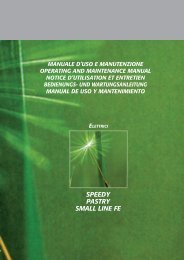IT - EN - Foinox
IT - EN - Foinox
IT - EN - Foinox
You also want an ePaper? Increase the reach of your titles
YUMPU automatically turns print PDFs into web optimized ePapers that Google loves.
6<br />
Temperature ad alto rischio proliferazione batterica<br />
Abbassando repentinamente la temperatura del prodotto, vengono ridotti i rischi di proliferazione batterica: e’<br />
necessario infatti assicurarsi che la carica batterica sia sempre sotto controllo. Più a lungo un prodotto viene<br />
lasciato stazionare a temperatura ambiente o, dopo la cottura, anche in una cella frigorifera, cioè sotto i + 65 C° e<br />
sopra i + 3C° maggiore è lo sviluppo batterico e quindi più veloce il deterioramento irreversibile del prodotto.<br />
In questa fascia di temperatura, infatti, l’azione della carica batterica aumenta in maniera da creare una<br />
decomposizione precoce dei prodotti, con un conseguente rischio di intossicazione, provocato dal rilascio di tossine<br />
da parte di batteri.<br />
Il processo di abbattimento provoca uno shock termico, inibendo in questo modo la proliferazione di<br />
colonie di batteri.<br />
Da considerare anche che negli ambienti di lavoro spesso le temperature si aggirano attorno ai 30°C, temperature<br />
sfortunatamente ideali per consentire ai batteri di riprodursi.<br />
temperatura<br />
temperature<br />
microcristalli<br />
mycrocrystals<br />
senza abbattitore<br />
without blast chiller<br />
con l’abbattitore<br />
with blast chiller<br />
temperatura ad alto<br />
rischio proliferazione<br />
batterica<br />
High risk temperature<br />
for bacterical<br />
proliferation<br />
macrocristalli<br />
macrocrystals<br />
tempo - time<br />
High risk temperature for bacterical proliferation<br />
By suddenly lowering the temperature of the product, the risk of bacterial proliferation is reduced. In fact, the amount<br />
of bacteria must be monitored at all times.<br />
The longer a product is left at room temperature, or even in a refrigerator after cooking, that is, below + 65 C° and<br />
more than + 3 C°, the higher the development of bacteria and hence the irreversible deterioration of the product.<br />
In this temperature range, the bacterial action increases such that it creates premature decomposition of the product,<br />
with subsequent risk of poisoning caused by the release of toxins by a part of the bacteria.<br />
The chilling process causes thermal shock, thus preventing the proliferation of colonies of bacterial.<br />
It should also be considered that in working environments temperatures often reach 30°C, which is unfortunately a<br />
perfect temperature for bacteria to reproduce.




